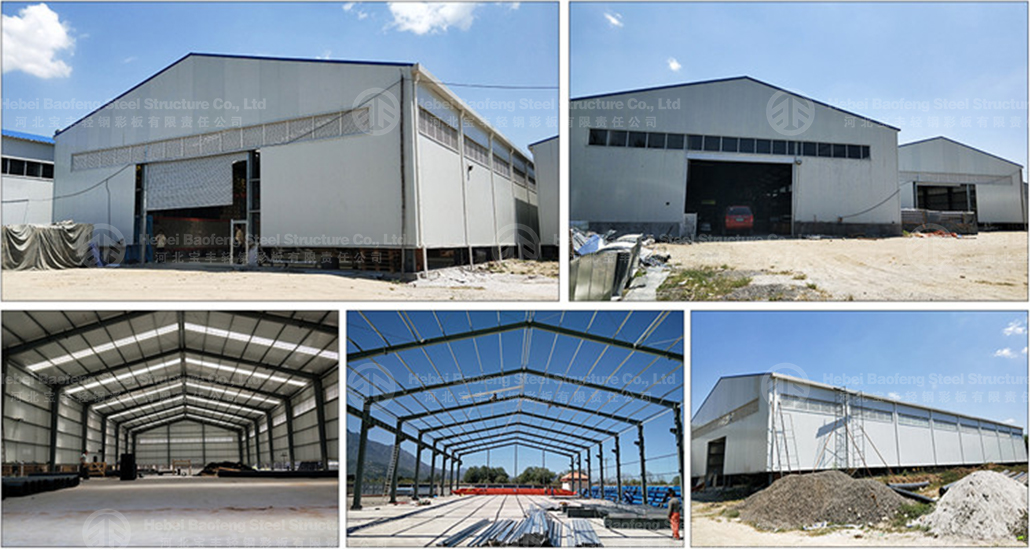
Is a steel warehouse durable in harsh weather conditions?
The durability of a steel structure warehouse in harsh weather is one of its primary advantages. In short, a properly designed, manufactured, and maintained steel structure warehouse is exceptionally durable in harsh weather conditions.
Here’s a detailed breakdown of how steel structures handle different harsh weather elements and what is required to ensure their durability.
Strengths of Steel in Harsh Conditions
1.High Wind Resistance:
Why it's strong:Steel has an excellent strength-to-weight ratio. Structural components like rigid frames can be engineered to withstand extremely high winds, including hurricanes and tornadoes. The entire structure can be securely anchored to a concrete foundation to resist uplift forces.
Key Factor:Professional engineering is non-negotiable. The design must comply with local building codes, which specify wind load requirements based on the geographic location.
2.Heavy Snow Loads:
Why it's strong:Steel is very strong in both tension and compression. The roof system can be designed with a steep enough pitch and strong enough rafters and columns to support the weight of heavy, wet snow without collapsing.
Key Factor:The building must be designed for the specific ground snow load of the region. A building designed for a light snow load in a temperate climate would fail under the snow loads seen in, for example, Northern Japan or Canada.
3.Seismic Activity (Earthquakes):
Why it's strong:Steel is ductile, meaning it can bend and flex without suddenly fracturing. This flexibility allows a well-designed steel frame to absorb and dissipate the energy of an earthquake, making it one of the best materials for seismic zones.
Key Factor:Again, specialized engineering is required to meet seismic design codes.
4.Resistance to Pests and Rot:
Unlike wood, steel is impervious to termites, ants, and rodents that can chew through structural members. It also cannot rot or develop mold from within, which is a significant advantage in damp, humid climates.
Potential Vulnerabilities and How to Mitigate Them
While the structural frame is robust, the building's longevity depends on protecting it from its main enemy: corrosion (rust).
1.Moisture, Humidity, and Salt Spray:
The Risk:Over time, exposure to rain, humidity, and especially salt spray in coastal areas can cause steel to rust, weakening the structure.
The Solution:
Galvanization:This is the most critical protection. The steel members are hot-dip galvanized, meaning they are coated with a layer of zinc. The zinc sacrificially protects the underlying steel from rust, even if the surface is scratched.
High-Quality Paint Systems:Additional paint coatings (often polyester, siliconized polyester, or PVDF) are applied over the galvanization. These paints provide color and an extra layer of protection against UV rays and corrosive elements. PVDF coatings are especially recommended for coastal or highly industrial environments.
2.Impact Resistance (Hail, Debris):
The Risk:The structural frame is safe, but the roof and wall cladding (sheets) can be dented by large hail or flying debris during a storm.
The Solution:Specify a thicker gauge (heavier) steel for the roof and wall panels. A 26-gauge panel is standard, but upgrading to 24-gauge or even 22-gauge provides significantly better impact resistance.
Climate-Specific Considerations
Coastal Areas:Specify a higher grade of galvanization (e.g., G90 or higher) and a premium paint system like PVDF.
Heavy Snow Areas:Ensure the design includes the correct snow load and a sufficiently sloped roof.
High-Wind / Hurricane-Prone Areas:The building must be professionally engineered for high wind speeds. This includes reinforced frames, hurricane clips, and secure foundation connections.
Extreme Heat & Sun:High-quality, reflective paint finishes (like light colors) can help reflect UV rays, reducing heat buildup inside the warehouse and slowing the degradation of the paint system.

Thể loại
blog mới nhất